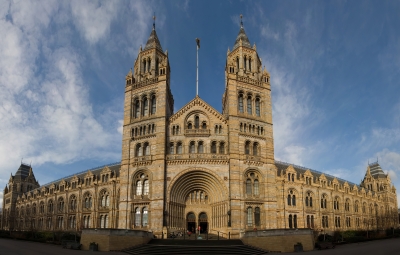
Founded in 1756 as a branch of the British Museum, the NHM became an independent institution in 1963. Since 1881, the museum is housed in an imposing Victorian-style building designed by English architect Alfred Waterhouse.
An extension designed by the Danish firm C.F. Møller, the Darwin Centre, was opened in 2009.
Together with the Science Museum and the Victoria and Albert Museum, the HNM is one of the three major museums located on Exhibition Road, in South Kensington, one of the most renowned cultural districts in Europe.
The program of events and activities of the NHM features temporary exhibitions, special events, guided tours, workshops, and educational programs. The museum includes three shops, four cafes, a grill restaurant, and a free picnic area.
Most of the Natural History Museum is accessible to people with disabilities; a limited number of wheelchairs are available, free of charge.
High above the Museum’s main attractions there’s another decorative feature that’s easy to miss, unless you know where to look.
The building’s gallery ceilings are adorned with intricate tiles displaying a vast array of plants from all over the world, with Hintze Hall’s ceiling alone covered with 162 individual panels.
These beautifully designed tiles reflect an era when exotic plant specimens flooded into Britain, sparking public interest in botany and horticulture.
Picture Credit : Google

